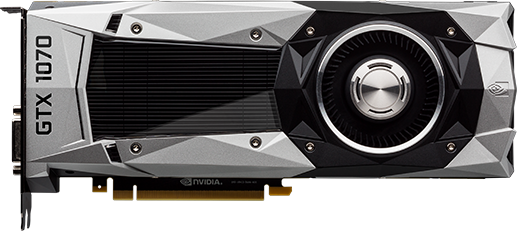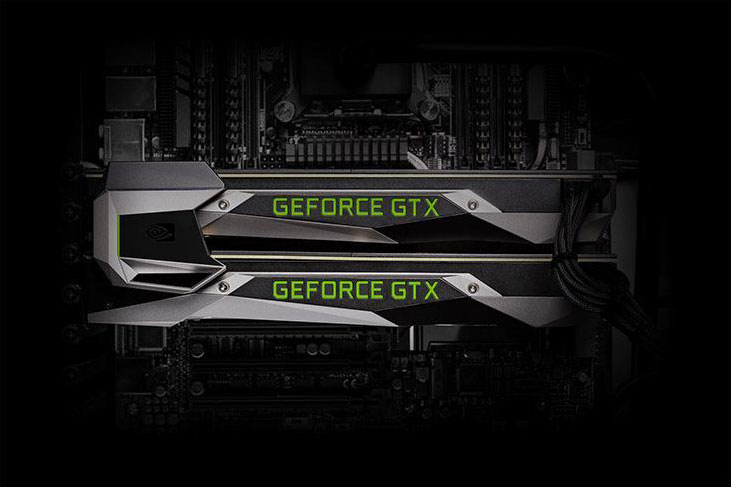Nvidia GTX 1070: The Full Specifications
Nvidia rocked the world of desktop graphics cards a couple of weeks ago when it announced the GTX 1080 and GTX 1070, and what the highly anticipated Pascal architecture can do. The main focus was on the granddaddy of graphics processors, the GTX 1080, for the first couple of weeks. Now that the embargo on GTX 1080 information has passed, Nvidia is starting to talk about its little brother, the GTX 1070.
The GTX 1070 is the direct replacement for the GTX 970, and just like its Maxwell cousin, the GTX 1070 is a major departure from the previous generation card. The 970 has been a favorite in the enthusiast gaming market since it was first launched in September 2014, and on paper, it appears as though the 1070 will fill that same role.
The GTX 1070 features a Pascal GPU built on a 16nm FinFET process node. The GPU features 1920 Cuda cores with a base clock of 1506 MHz, and it boosts to 1683 MHz when faced with heavy load. That’s over 500 MHz faster than the boost clock of a reference GTX 970.
Not Using GDDR5X
The GTX 1070 also features 8GB of GDDR5, which is twice as much memory as the previous generation (even more if you consider the 970 really only uses 3.5GB efficiently). The memory that Nvidia included on the GTX 1070 is also quite a bit faster than the previous model. The 1070 isn’t using Micron’s new GDDR5X memory that the 1080 comes with, but the clock speed has been increased significantly. Overclocked GTX 970s from Nvidia’s partners were sometimes paired with 7 Gbps memory. The base model GTX 1070 boasts 8 Gbps memory modules. Nvidia stuck with the 256-bit memory bus, but the faster memory translates to 256 GB/s. For comparison, the reference GTX 980 offers 224 GB/s.
Faster Than A Titan X
At the Pascal press event on May 6, Nvidia’s Founder, Jen-Hsun Huang, declared that both the GTX 1080 and the GTX 1070 will outperform a Titan X, the company’s former “halo” card. The 1070 can manage up to 6.5 TFLOPS of floating point performance. The card is also capable of delivering a far higher resolution that previously possible: The GTX 1070 can drive 7680x4320 pixels @60Hz. Thanks to Pascal’s incredible efficiency, the GTX 1070 can do all of that while consuming 150 W or less, and it requires only a single 8-pin power connector.
The GTX 1070 will support SLI, but it requires a special high-bandwidth bridge to do so. Nvidia is somewhat moving away from three-way and four-way SLI with the GTX 1080 by requiring extra steps to enable extra cards. We’re not sure if there will be ways to enable more than two GTX 1070s.
| Nvidia GeForce GTX 1070 | |
|---|---|
| GPU Engine Specs: | Row 0 - Cell 1 |
| NVIDIA CUDA | 1920 |
| Base Clock (MHz) | 1506 |
| Boost Clock (MHz) | 1683 |
| Memory Specs: | Row 4 - Cell 1 |
| Memory Speed | 8 Gbps |
| Standard Memory Config | 8 GB GDDR5 |
| Memory Interface Width | 256-bit |
| Memory Bandwidth (GB/s) | 256 |
| Technology Support: | Row 9 - Cell 1 |
| Multi-Projection | Yes |
| VR Ready | Yes |
| NVIDIA Ansel | Yes |
| NVIDIA SLI | Yes - SLI HB Bridge |
| NVIDIA G-SYNC-Ready | Yes |
| NVIDIA GameStream-Ready | Yes |
| NVIDIA GPU Boost | 3.0 |
| Microsoft DirectX | 12 API with feature level 12.1 |
| Vulkan API | Yes |
| OpenGL | 4.5 |
| Bus Support | PCIe 3.0 |
| OS Certification | Windows 7-10, Linux, FreeBSDx86 |
| Display Support: | Row 22 - Cell 1 |
| Maximum Digital Resolution | 7680x4320@60Hz |
| Standard Display Connectors | DP 1.4 |
| Multi Monitor | Yes |
| HDCP | 2.2 |
| Graphics Card Dimensions: | Row 27 - Cell 1 |
| Height | 4.376" |
| Length | 10.5" |
| Width | 2-slot |
| Thermal and Power Specs: | Row 31 - Cell 1 |
| Maximum GPU Temperature (in C) | 94 |
| Graphics Card Power (W) | 150 W |
| Recommended System Power (W) | 500 W |
| Supplementary Power Connectors | 8-pin |
Nvidia will launch the GTX 1070 on June 10. The Founders Edition will retail for $449, and Nvidia’s partners will be able to sell their own custom cards for as little as $379.
Get Tom's Hardware's best news and in-depth reviews, straight to your inbox.
Follow Kevin Carbotte @pumcypuhoy. Follow us on Facebook, Google+, RSS, Twitter and YouTube.
Kevin Carbotte is a contributing writer for Tom's Hardware who primarily covers VR and AR hardware. He has been writing for us for more than four years.
-
TechyInAZ For $370. That's a steal! My best guess is that the GTX 1070 will be inbetween the GTX 980 and 980ti/titanX in terms of performance, according to what I see in the specs.Reply -
bak0n Looks like we've finally reached overkill for 1080P mainstream and pushed 1440P into mainstream pricing.Reply -
mouse24 ReplyLooks like we've finally reached overkill for 1080P mainstream and pushed 1440P into mainstream pricing.
Not sure if I would call a 400 dollar GPU mainstream. Maybe in the 200 range, yes. -
Xyos This article is incorrect about the SLI bridge. You can STILL use a standard bridge for SLI. The HA bridges are only required for 5k and higher, and they claim to reduce stuttering.Reply -
JackNaylorPE 3 and 4 way SLI was good for getting your name on benchmark leader boards but, unlike 2x SLI, the cost could never be justified given the ROI ... no loss here if you have to jump thru a few hoops to "go there". Those chasing leader board status or powering 3 monitors will still make the trip.Reply
1080p is over ... you can't even buy a 144/165 Hz IPS screen with < 5 ms response times at 1080p ... manufacturers haven't seen it worth the T & E.
The cost is still less than what we were willing to pay got the 670 (May 2012) and 770 (May 2013). So after 4 years, a $379 price is still pretty welcome. I remain convinced that nVidia used predatory pricing on the 970 selling with the intend of putting a big hurt on AMD at a time when they had nothing that could compete in that price range (when all cards were overclocked) and were in precarious financial straights.
What the $329 release price and under $300 current price has also done is get many folks to move up to a 950 / 960 and now, one would expect, they now might be accustimes to staying at the xx70 level for future builds. -
thburninator We'll see what the benchmarks say. If the 1070 doesn't provide "maxed out" performance at 1440p, I don't see the reason to upgrade from the 970. The 970/390 are the 1080p golden boys right now, and if the 1070 doesn't bump it up to 1440p, I don't think it's a worthwhile investment (for those upgrading, that is).Reply -
George Phillips Considering inflation, at$449/379, this think is a total winner. It will definitely also crash GTX 980 Ti and Titan X even without tweaking, and it comes with 8GB of G5 memory!!!Reply

